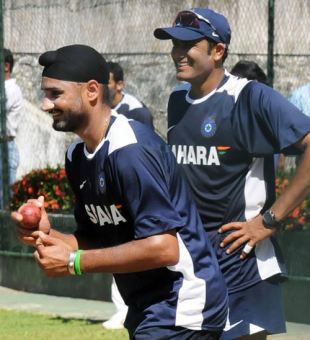A test for India's big guns
A team that loves playing at home is to play three Tests against a team that has performed well overseas in recent years - except that India are hardly a visiting side when in neighbouring Sri Lanka
Jamie Alter in Colombo
22-Jul-2008

| ||
A team that loves playing at home is to play three Tests against a team that has performed well overseas in recent years - except that India are hardly a visiting side when in neighbouring Sri Lanka. From the first day of the first Test against Sri Lanka at the SSC, India have an anomaly to set straight: they have only won one Test series in Sri Lanka in four attempts, and their record in the Emerald Isle reads - played 12, won 2, lost 3, drawn 7.
The dynamics of Indian cricket may have changed - no longer are they a side expected to do well on slow and low Asian pitches - but in fact, they have struggled in such conditions in Sri Lanka as well, winning only two Test - at Kandy in 2001 and in 1993 - out of 12.
India's batsmen, especially Virender Sehwag, Sachin Tendulkar and VVS Laxman, like the ball to come on to the bat. India's most famous victories in recent years have come overseas - in Johannesburg and Perth. Unlike India, Sri Lanka's batting revolves around two men, Mahela Jayawardene and Kumar Sangakkara, but the conditions suit their style of play. The SSC is their fortress; few sides have been able to break in. Whenever Jayawardene walks to the crease at the SSC [where he has scored a record 2062 runs], a century seems there for the taking.
While other countries in the subcontinent have found it hard to win series at home, Sri Lanka have a formidable record at home. Apart from losses to Australia, almost expected at the time, and two to Pakistan, their record in this decade reads 25 wins from 45 Tests. Sri Lanka's greatest strength is that they play their home conditions very, very well.
Against their formidable home advantage, Sri Lanka are trying to find a settled Test XI. Sanath Jayasuriya's retirement has left a void. What he brought to the top order was immense - when India toured Sri Lanka in 1996-97, Jayasuriya scored 570 runs at 190.33, with 340 coming in one epic innings; his overall average against India was 67, while his left-arm spin was a huge bonus. Sri Lanka's likely openers, Michael Vandort and Malinda Warnapura, have played 20 Tests between them. This puts immense pressure on Sangakkara and Jayawardene, but in recent times they have thrived in that adversity.
India have a more balanced bowling attack, with better new-ball operators in Zaheer Khan and Ishant Sharma, but with Chaminda Vaas and Muttiah Muralitharan boasting more than 1000 Test wickets between them, Sri Lanka can be quietly confident of having the more potent attack.
On paper India hold the advantage in batting and bowling. If Rahul Dravid or Sachin Tendulkar - who needs another 172 runs to overhaul Brian Lara's Test record of 11,953 runs - fail, India have VVS Laxman and Sourav Ganguly to follow. Sri Lanka have Thilan Samaraweera and Tillakaratne Dilshan, both of whom haven't completely cemented their places in the Test team.
Local experts reckon the SSC pitch will assist the fast bowlers for about 90 minutes, before becoming a perfect batting track. Vaas aside, Sri Lanka don't have a new-ball bowler to trouble the very best, with Lasith Malinga, Dilhara Fernando and Farveez Maharoof currently stuck on the treatment table. Murali doesn't always like to come on to bowl early, and Ajantha Mendis is yet to play Test cricket. If Sehwag gets stuck in and starts pillaging the new-ball attack, Sri Lanka might be short on options.
Also, Sangakkara not keeping wicket creates a problem in terms of fitting an allrounder who can bowl. Unlike India, Sri Lanka do not have a Ganguly who can bowl 10-12 overs of accurate medium-pace a day, as well as Sehwag's tidy, partnership-breaking offspin. Dilshan has filled this role well occasionally in one-day cricket, but not in Tests.
India's spin attack consists of two proven match-winners in Anil Kumble and Harbhajan Singh. There is no doubting Murali's record, but as Kumble pointed out, all the pressure is on Mendis. He stunned India in the Asia Cup final this month but should he make his Test debut here, he will be up against a very different batting line-up. There are no Rohit Sharmas, Yuvraj Singhs, Suresh Rainas or Robin Uthappas here.
This series will also be a trial of sorts for Harbhajan. He did little with the ball in Australia, and though he was Man of the Series against South Africa not too long ago, he took wickets on a minefield in Kanpur. With the likes of Pragyan Ojha and Piyush Chawla also in contention for the second spinner's spot, and RP Singh or Munaf Patel able to fill the role of third seamer, Harbhajan is under pressure to get his act together. If he does, India would have taken a few important steps towards correcting their poor record in Sri Lanka.
Jamie Alter is a staff writer at Cricinfo